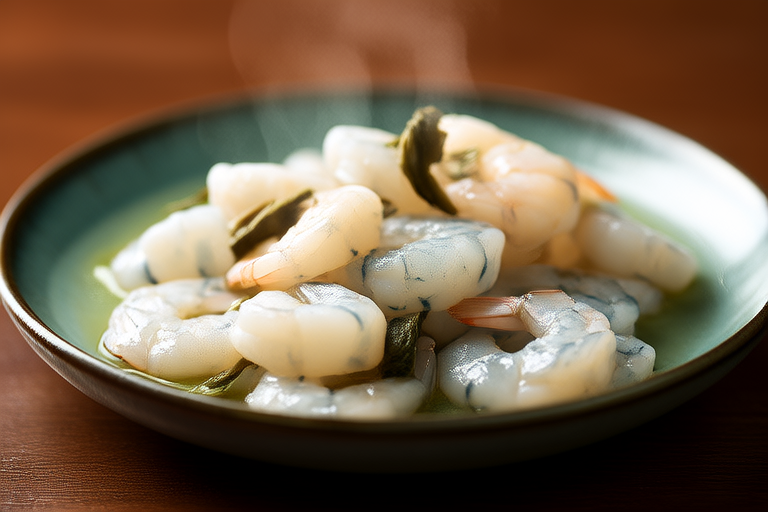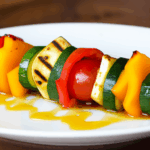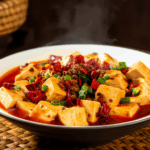Succulent Longjing Shrimp with Tea
Introduction
In the realm of culinary arts, the fusion of flavors from different cultures often leads to dishes that are not only visually appealing but also deeply satisfying in taste. One such masterpiece is the Succulent Longjing Shrimp with Tea. This dish combines the delicate and refreshing notes of Longjing tea with succulent, plump shrimp, creating a harmonious balance of flavors that will delight your palate. The recipe below will guide you through each step of preparing this exquisite dish, ensuring that you can recreate it at home with ease.
Ingredients
- Large shrimp (200 grams)
- Longjing tea (5 grams)
- Ginger (10 grams), finely chopped
- Green onions (20 grams), chopped
- Garlic (10 grams), minced
- Vegetable oil (3 tablespoons)
- Salt (to taste)
- Pepper (to taste)
- Soy sauce (2 tablespoons)
- Shaoxing wine (1 tablespoon)
- Water (as needed)
The choice of ingredients is crucial for achieving the perfect balance of flavors in this dish. The shrimp should be fresh and large enough to ensure succulence. Longjing tea, also known as Dragon Well tea, is a green tea that originates from Zhejiang Province in China. It is renowned for its fresh, grassy flavor and aroma, which complements the natural sweetness of the shrimp. Ginger, garlic, and green onions add depth and warmth to the dish, while soy sauce and Shaoxing wine enhance the umami flavor.
Preparation
- Prepare the Shrimp: Start by peeling the shrimp and removing the veins. Rinse them thoroughly under cold water and pat dry with paper towels. Season the shrimp with salt and pepper, ensuring each piece is evenly coated. Set aside for a moment while you prepare the other ingredients.
- Brew the Longjing Tea: In a small pot, bring 200 ml of water to a boil. Add the Longjing tea leaves and let them steep for about 3-4 minutes. Strain the tea into a bowl, discarding the leaves. You should have approximately 150 ml of brewed tea. Allow the tea to cool slightly before using it in the next steps.
- Heat the Oil: In a wok or large frying pan, heat 2 tablespoons of vegetable oil over medium-high heat. Once the oil is hot, add the minced garlic and ginger. Stir-fry for about 30 seconds until fragrant but not browned.
- Cook the Shrimp: Increase the heat to high and add the seasoned shrimp to the wok. Cook for about 2-3 minutes on each side until they turn pink and opaque. Remove the shrimp from the wok and set aside on a plate.
- Combine Ingredients: In the same wok, reduce the heat to medium and add the remaining 1 tablespoon of vegetable oil. Pour in the brewed Longjing tea and stir well. Add the soy sauce and Shaoxing wine, stirring continuously to prevent burning.
- Simmer the Sauce: Let the mixture simmer for about 2-3 minutes, allowing the flavors to meld together. The liquid should reduce slightly, becoming thicker and more flavorful. Taste and adjust seasoning with additional salt and pepper if necessary.
- Finish the Dish: Return the cooked shrimp to the wok and toss gently to coat them evenly with the sauce. Sprinkle the chopped green onions over the top and cook for another minute to infuse the dish with their aroma.
- Serve: Transfer the Succulent Longjing Shrimp with Tea to a serving plate. Garnish with additional chopped green onions if desired. Serve immediately while the shrimp are still warm and tender.
The preparation process is straightforward yet requires attention to detail to achieve the best results. Each step contributes to the final dish’s complexity and flavor profile. By following these instructions carefully, you can create a dish that not only tastes delicious but also looks beautiful on the plate.
Cooking Tips
- Use freshly brewed Longjing tea for the best flavor. Avoid using pre-brewed or instant tea, as it may alter the taste.
- Ensure the shrimp are fully cooked but still retain their succulence. Overcooking can make them tough and rubbery.
- Adjust the amount of soy sauce and Shaoxing wine according to your personal preference. Some people prefer a stronger umami flavor, while others enjoy a more subtle taste.
- If you’re short on time, you can use pre-cooked shrimp. However, cooking the shrimp yourself ensures optimal texture and flavor.
These tips will help you fine-tune the dish to suit your taste preferences and cooking style. Whether you’re an experienced chef or a beginner, these suggestions will guide you toward creating a memorable meal.
Pairing Suggestions
The Succulent Longjing Shrimp with Tea pairs wonderfully with various side dishes and beverages. Here are some recommendations:
- Rice: A simple steamed rice complements the dish beautifully, absorbing the flavorful sauce.
- Noodles: If you prefer noodles, try pairing the shrimp with a light vegetable stir-fry or a clear soup.
- Salad: A crisp salad with mixed greens, cucumbers, and a light vinaigrette can provide a refreshing contrast to the rich flavors of the dish.
- Beverage: Since the dish already contains Longjing tea, consider serving a light white wine or a herbal infusion to complement the meal without overpowering the flavors.
These pairings enhance the overall dining experience, making the meal more enjoyable and balanced.
Conclusion
The Succulent Longjing Shrimp with Tea is a delightful fusion of flavors that showcases the versatility of Chinese cuisine. By combining the freshness of shrimp with the aromatic notes of Longjing tea, this dish offers a unique and satisfying culinary experience. Whether you’re hosting a dinner party or simply enjoying a quiet evening at home, this recipe is sure to impress and delight your guests. Happy cooking!


